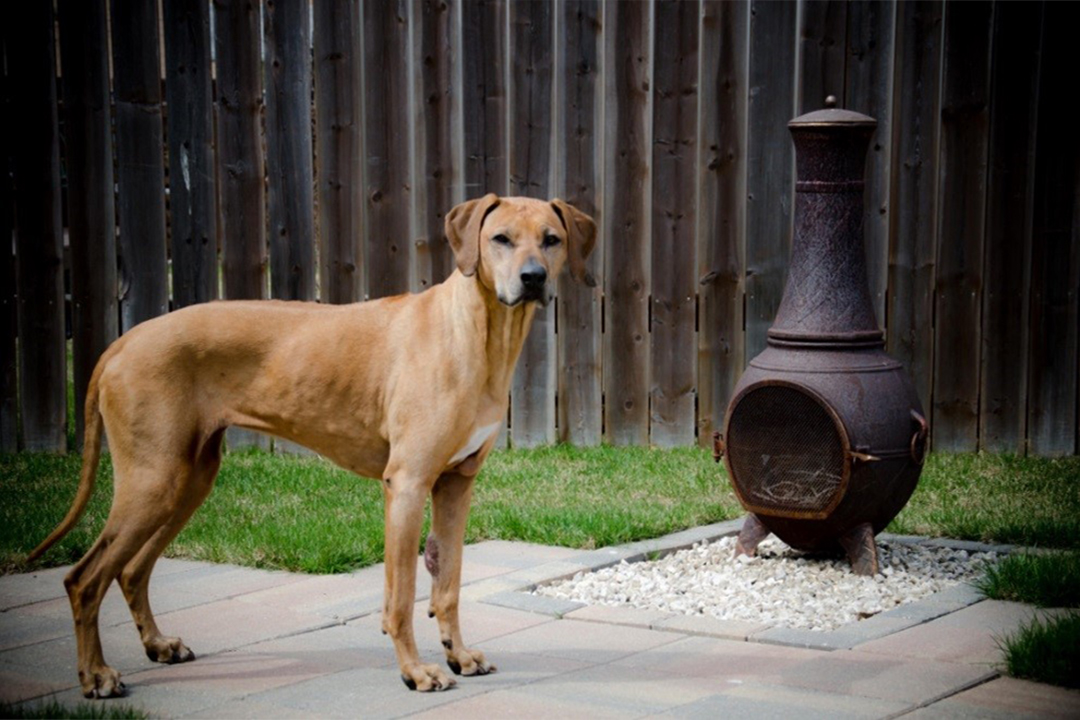
New treatment for pets’ cancer appeals to owners
The Western College of Veterinary Medicine (WCVM) is now offering a new treatment option for pets with certain types of cancer.
By Tayler BelosowskyVeterinary oncologists Dr. Monique Mayer and Dr. Jerome Gagnon, along with their team, are studying stereotactic body radiation therapy (SBRT) as a treatment choice for dogs with soft tissue sarcomas, a specific type of tumour commonly found on the skin.
For Melissa and Derrick Burnside, this new treatment provided a chance for their dog Lulu to receive cancer treatment while having her owners with her every step of the way. Lulu was diagnosed with a soft tissue sarcoma on her left front leg in late May 2016 by Dr. Tracy Radcliffe at the Brandon Animal Clinic. Radcliffe (WCVM ’99) then referred the family to the WCVM’s oncology team.
“It all of a sudden just blew up,” Derrick says. “We got really concerned about it because of how fast it grew.”
On Aug. 15, 2016, the Burnside family drove from their home in Dauphin, Man., to Saskatoon to meet with doctors and discuss treatment options for Lulu.
“They said they would set us up with an appointment with both [radiation oncology and surgery] just so that we could know all of our options,” says Melissa. “At first we actually thought we were going to have surgery.”
But after discussing options with the surgical team, the Burnsides decided that radiation therapy was the better choice for Lulu. Since it’s common for soft tissue sarcomas to extend into the surrounding tissue far beyond what is see from the outside, the tumours usually require aggressive surgery. However, Lulu’s tumour was in a location that made its complete removal unlikely.
“Once she [the surgeon] actually was able to look at it, she said there was a 50 per cent chance that it would grow back because of where it was,” Melissa says.
The Burnsides then had to decide between conventional radiation therapy and SBRT. For them, it was an easy decision.
“Regular, traditional radiation wouldn’t be an option for us based on the fact that we do live in Manitoba and it takes three weeks,” says Melissa.
“To sit there and think about her being with some other family and not being able to see her and comfort her and stuff like that, that wasn’t an option really,” adds Derrick.
Luckily for Lulu and her family, SBRT provided a new alternative for curative treatment. This treatment option allows a precise dose of radiation to be directed at the tumour, while avoiding healthy tissues and vital organs.
SBRT also allows for shorter treatment times compared to other modes of therapy as it involves three treatments in three consecutive days. The treatment time per day is usually less than half an hour and involves the dog being placed under general anesthesia to ensure that the animal is placed in the exact position that matches the CT scan from the previous day.
After Lulu had bloodwork and chest radiographs done to ensure that she was healthy enough to undergo general anesthesia, she had a CT scan so that the veterinarians could view the tumour and any surrounding organs that might be affected.
The Burnsides returned to Saskatoon the following week to start Lulu’s treatment.
“We would bring her in at about eight or 8:30 in the morning and then usually she was ready to go shortly after lunch,” said Melissa.
After each treatment, the Burnsides would take Lulu to their hotel so she could be with them for the evening.
“Overall, she was pretty normal,” says Melissa.
“A little sleepy from the anesthetic,” says Derrick.
Lulu also became “less eager” to go for treatment and be away from her family by the third day; that’s another reason the Burnsides were glad they had chosen SBRT for treatment.
By Aug. 24 Lulu had finished treatment and Melissa and Derrick were able to take her back to Manitoba.
Although the short treatment time decreases the likelihood of acute side effects such as hair loss, skin redness and discomfort compared to conventional radiation therapy, these types of side effects are still possible, especially if the dog licks or bites at the area.
“I did my best to keep a cone on her and then we also modified a sock so that we could put that over top so that she couldn’t lick at it,” says Melissa.
The Burnsides put great effort into ensuring that Lulu healed as fast as possible. However, they needed to be patient since SBRT causes the tumour to shrink slowly over time.
“It took probably a solid six months to finally finish healing up,” says Melissa.
“And it got worse before it got better,” says Derrick.
“We sent pictures to Dr. Fan (WCVM clinician), making sure that it was looking the way it was supposed to. It was pretty ugly for a while,” he adds.
In the end, the Burnsides say they are satisfied with their choice of treatment and would “most definitely” choose SBRT again.
“We don’t have kids. These are our kids,” says Derrick. “If there was any chance of doing anything we could to save her and try and make her better, it was going to happen.”
Tayler Belosowsky of Saskatoon, Sask., is a second-year veterinary student who was part of the WCVM’s Undergraduate Summer Research and Leadership program in 2017. Tayler’s story is part of a series of stories written by WCVM summer research students.
